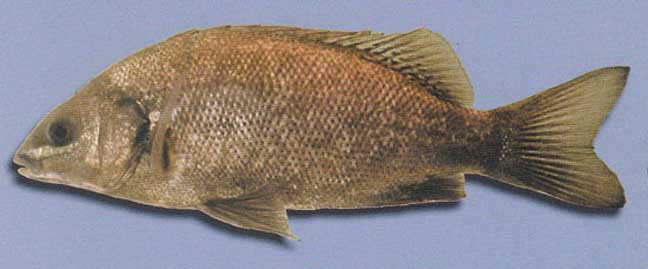Smallhead Grunter, Scortum parviceps (Macleay 1883)

Smallhead Grunter, Scortum parviceps. Source: John Merrick. License: all rights reserved
Smallhead Grunter, Scortum parviceps (Macleay 1883)
More Info
|
Distribution |
Known only from the upper Burdekin River, Queensland. Inhabits rapids, riffle areas and pools in fast-flowing clear freshwater streams, over a mix of sand, gravel and bedrock substrates. |
|
Features |
Dorsal fin XIII,10-11; Anal fin III,9; Pectoral fin 15-16; Pelvic fin I,5; Lateral line scales 49-53; Transversecscales 8-10/1/20-22; Gill rakers 9-10+1+18-22; Vertebrae 11+14. Body moderately deep, 2.6-2.9 in SL, ovate, compressed. Dorsal profile straight or slightly convex to nape, then straight to origin of dorsal fin. Dorsal profile much more pronounced than ventral. Ventral profile straight to isthmus; slightly convex from isthmus to insertion of pelvic fins, then straight from insertion to anus. head length 3.0-3.5 in SL; snout length 3.0-3.5 in HL; eye width 3.7-5.0 in HL; jaw length 3.4-3.8 in HL; jaws equal, lower jaw slightly flattened, with teeth projecting slightly outward. Gape horizontal. Snout elongate. Maxillary reaching to vertical through anterior of eye in young, falling short with age, reaching only to vertical through posterior nostril. Teeth slightly flattened, depressible with outer row enlarged. Young with vomerine teeth. Vomers and palatines smooth in adults (some adults with one or two vomerine teeth). Interorbital region smooth. Nostrils separated by a distance equal to or slightly greater than diameter of posterior nostril. Lacrimal serrate in young; serrations reduced in adults. Preoperculum serrate; serrations largest on angle. Lower opercular spine stronger and longer; not extending beyond edge of opercular lobe. Cleithrum exposed; serrate posteriorly; scales on side. Supracleithrum exposed. Posttemporal exposed; serrate along posterior edge. Scales finely ctenoid; lateral line continuous, smoothly curved; 3-4 scales on caudal; 51-61 scales above lateral line; 8-10 scales below lateral line; 16-20 predorsal scales to occiput; two rows of scales in sheath at base of dorsal, sheath extending to seventh or eighth dorsal ray; 3-4 rows of scales in sheath at base of anal, sheath extending across base of all rays; cheek scales in 4-6 rows. Dorsal fin continuous, base 1.65-1.8 in SL; spinous portion arched; first spine very short; fifth or sixth spines longest, 1.8-2.0 in HL, those following decreasing in length to penultimate which is approximately as long as ultimate. Longest dorsal spine longer than longest dorsal rays; longest dorsal ray 1.8-2.0 in HL; soft dorsal angular; posterior border straight. Second and third anal spines subequal; longest shorter than longest anal rays, longest anal spine 2.2-2.5 in HL; longest anal ray 1.6-1.7 in HL, posterior margin of soft anal obliquely truncate or slightly convex. Pectoral fins asymmetrically pointed; first ray longest and slightly filamentous; reaching to anus; falling short with age. Caudal fin deeply emarginate. |
|
Size |
To 38 cm SL. |
|
Feeding |
Omnivore - feeds mostly on algae, aquatic macrophytes and aquatic insects. Also consumes small fishes, crustaceans and molluscs. |
|
Biology |
Oviparous pelagic spawners; breeding is thought to occur between October and November. Eggs pelagic, large 4.2-4.3 mm. Larvae hatch after 36 hours. |
|
Etymology |
The specific name parviceps, from the Latin parvus (= small), and -ceps (= head), in reference to the relatively small head of this species compared with those of other members of the genus. |
|
Species Citation |
Therapon parviceps Macleay 1883, Proc. Linn. Soc. N.S.W. (1)8(2): 201. Type locality: Upper Burdekin River, Queensland. |
|
Author |
Gomon, M.F. & Bray, D.J. 2023 |
|
Resources |
Smallhead Grunter, Scortum parviceps (Macleay 1883)
References
Allen, G.R. 1989. Freshwater Fishes of Australia. Neptune, New Jersey : T.F.H. Publications 240 pp., 63 pls.
Allen, G.R., Midgley, S.H. & Allen, M. 2002. Field guide to the freshwater fishes of Australia. Perth : Western Australian Museum 394 pp.
Brooks, S., Ebner, B. & Kennard, M. 2019. Scortum parviceps. The IUCN Red List of Threatened Species 2019: e.T20050A123379120. https://dx.doi.org/10.2305/IUCN.UK.2019-3.RLTS.T20050A123379120.en. Accessed on 18 October 2023.
Davis, A.M., Unmack, P.J., Pusey, B.J., Pearson, R.G. & Morgan, D.L. 2013. Ontogenetic development of intestinal length and relationships to diet in an Australasian fish family (Terapontidae). BMC Evolutionary Biology 13: 53, 16 pp.
Davis, A.M. & Pusey, B.J. 2010. Trophic polymorphism and water clarity in northern Australian Scortum (Pisces: Terapontidae). Ecology of Freshwater Fish 19: 638–643
Macleay, W.J. 1883. Notes on a collection of fishes from the Burdekin and Mary Rivers, Queensland. Proceedings of the Linnean Society of New South Wales 1 8(2): 199-213 See ref at BHL
Merrick, J.R. & Schmida, G.E. 1984. Australian Freshwater Fishes Biology and Management. Sydney : J.R. Merrick 409 pp. figs 280 col. figs.
Ogilby, J.D. & McCulloch, A.R. 1916. A revision of the Australian therapons with notes on some Papuan species. Memoirs of the Queensland Museum 5: 99-126, Pls. 10-13. (as Therapon parviceps) See ref at BHL
Pusey, B., Kennard, M. & Arthington, A. 2004. Freshwater Fishes of North-Eastern Australia. CSIRO Publishing Collingwood, Victoria. 684 pp.
Unmack, P.J. 2001. Biogeography of Australian freshwater fishes. Journal of Biogeography 28: 1053-1089
Vari, R.P. 1978. The terapon perches (Percoidei, Terapontidae) a cladistic analysis and taxonomic revision. Bull. Amer. Mus. Nat. Hist. 159(5): 175–340 figs 1–94.
Whitley, G.P. 1943. Ichthyological notes and illustrations. Part 2. The Australian Zoologist 10(2): 167-187 figs 1-10

